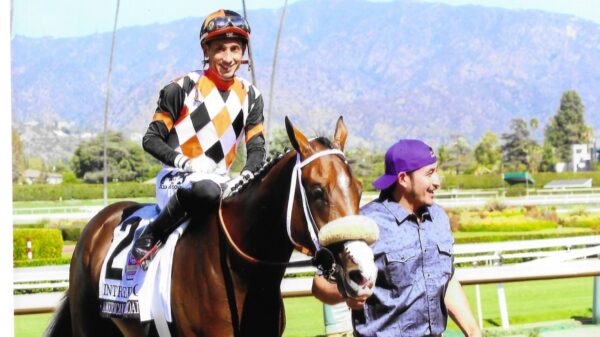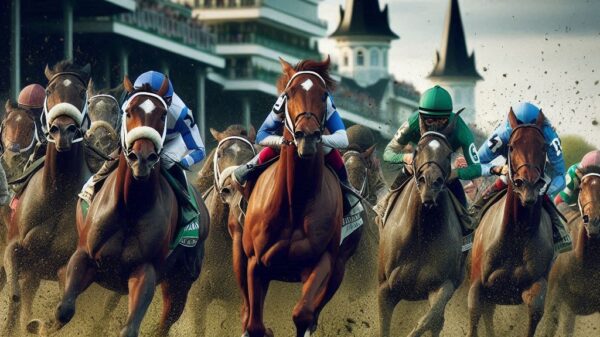
Rinaldo Del Gallo, III
By: Rinaldo Del Gallo, III
Recently, I came across a horse sired by Unusual Heat running in the DRF BETS “Race of the Day.” Unusual Heat was an unusually old sire, having a crop at the age of 27. But this has been outdone. My readings came across a horse named VALDINA ORPHAN (USA) b. H, 1939 {A1}, the winner of the first Lecomte Stakes. Valdina Orphan was not the best horse of his generation, but he was one of the best.

Valdina Orphan
Valdina Orphan beat Kentucky Derby winner SHUT OUT (USA) ch. H, 1939 {16-g} in the Dwyer, in a time when the Dwyer was a bigger race than it is today. That year Shut Out also won the Arlington Classic Stakes (then a big race), Belmont Stakes, Yankee Handicap, Blue Grass Stakes, and the Travers Stakes. In the Derby Trial, Valdina Orphan beat multiple stakes winner SUN AGAIN (USA) ch. H, 1939 {9-f}, and also beat Hall of Fame inductee ALSAB (USA) b. H, 1939 {27-a} who was third. Don’t get me wrong, Shut Out and Alsab beat Valdina Orphan a bunch of times, such as the 1942 Kentucky Derby that was held just after the Derby Trial. But on one occasion Valdina Orphan bested Alsab (the Derby Trial), and one one occasion Valdina Orphan bested Shut Out (the Dwyer).
But what I found odd was Valdina Orphan’s pedigree with respect to the excellent sire Broomstick. Valdina Orphan’s dam, STEPSISTER (USA) ch. M, 1930 {A1} was a daughter of that great sire, who lead the sire’s list thrice, 1913-1925, the broodmare sire’s list twice, 1932 and 1933, who was among the top 10 sires from 1910-1927; and had an unfathomable rate (by today’s standards) of siring 25% stakes winners including Regret. Not only was Broomstick a great sire, he was a great sire of sires.
But what I didn’t know was his number of crops. Broomstick’s first crop was in 1909, when Broomstick was 8 years of age. Among that first crop was Hall of Fame Horse WHISK BROOM (USA) ch. H, 1907 {4-m}, perhaps the greatest sire that never was the leading sire. Broomstick would have his last crop in 1931, when Broomstick was 30. When Broomstick was 29, in 1930, STEPSISTER (USA) ch. M, 1930 {A1} was born. Two years earlier, FERVOR (USA) b. H, 1928 {A1}, a full sister to Stepsister was born.
But this is where it gets a tad bit odd, even by horse racing breeding standards. Stepsister’s dam was RAPTURE (USA) b. M, 1923 {A1}, a winner of the Alabama Stakes, Pimlico Oaks, second in the Champion Filly Stakes, and 3rd in the Ladies Handicap and Coaching Club Oaks. Rapture won the Pimlico Oaks by 12 lengths. Black Maria came in 3rd in that Pimlico Oaks, and had a date with destiny as a future member of the Hall of Fame. Rapture had beaten that year’s eventual 3 year-old filly champion. Then, as today, the best was mated with the best and breeders’ hoped for the best. And that is how Valdina Orphan’s parents were picked out. The best stud was picked for the winner of the Alabama.
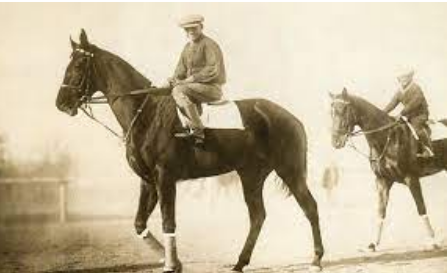
Valdina Orphan
In the odd turns, Rapture herself was the daughter of an unraced mare ENCHANTING (GB) ch. M, 1915 {A1}, who was sired by a grandson of St. Simon named ST. VICTRIX, who won the Wood Ditton Stakes and had but a handful of offspring. Enchanting was owned by the renowned H. P. Whitney of Brookdale Stud. Enchanting was imported to the USA in October 1915 by Mr Whitney. Enchanting was a good dam that had stakes winners ENCHANTMENT (USA) b. G, 1920 {A1}(Kentucky Club Stakes at 2, Harve DeGrace Handicap at 3, 4th in the Brooklyn Handicap at 4); FLAG DAY (USA) ch. H, 1926 {A1} (Long Beach Handicap) and stakes placed SAILING ALONG (USA) ch. M, 1919 {A1} (2nd Frivolity Stakes). For an unraced mare from a most modest sire, this was a pretty good broodmare.
Enchanting’s dam was CRINOLINE (USA) b. M, 1911 {A1}. I suspect that Crimoline was sent overseas because of the Hart–Agnew Law which banned horse racing in New York. According to Wikipedia, “Thoroughbred Times reported that more than 1,500 American horses were sent overseas between 1908 and 1913 and that of them, at least 24 were either past, present, or future Champions.” While I don’t have direct evidence that the Hart-Agnew Law was the cause of Enchanting being sent to England, it is highly likely to be a cause. According to pedigree query dot come, Crinoline was third in the Village Nursery H. (Leicester) in 1913. The same source says she was returned to the USA in October 1915. Crimonlin’s daughter Enchanting was born in 1915, when Crinoline was in England after being mated with Broomstick in the states. (A “crinoline” is a hooped dress).
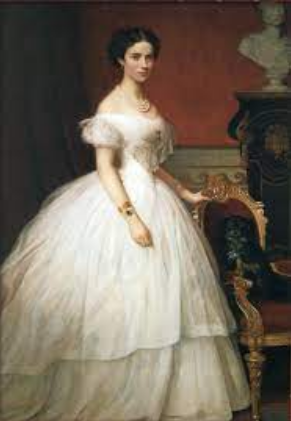
A Crinole Dress
Crinoline had a son named DAMASK (USA) br. G, 1917 {A1}, who was an excellent runner. Damask won the Louisiana Derby run at Jefferson Park that year, and set a new track record. The race would be run at Jefferson Park seven more times before it went back to the Fairgrounds. Damask only lost by a head to the great Exterminator in the 2 mile Autumn Gold Cup at Belmont. The race was run in 3:21.80, which was a North American Record. If losing by a head to a horse that set a new North American Record was not enough, the horse that came in 3rd was the great CLEOPATRA (USA) ch. M, 1917 {3-j}( Champagne S., Coaching Club American Oaks (NTR), Pimlico Oaks, Sun Bonnet H., Huron H., Latonia Championship (NTR), Alabama S.)(Cleopatra is in most pedigrees today through her son Pompey, who is among other things the the sire of Bold Ruler’s second dam). Damask was the only horse to take on Man O’War in the second running of the Jockey Club Stakes. What makes Damask interesting is that he started to run in Steeplechase races and started winning them. He won the Corinthian Steeplechase at Belmont at 20 furlongs in 1924, and the Manly Steeplechase in 1922 at Fair Hill, Maryland. Damask was in the money in at least 20 stakes races, some on the flat, some over the fences. His sire, ALL GOLD (GB) ch. H, 1908 {9-e} was even mated to Regret’s dam, Jersey Lightning. Damask is “a figured woven fabric with a pattern visible on both sides, typically used for table linen and upholstery”—you can see how that could come from “Crinoline,” a type of hooped dress.
Crinoline’s dam was PETTICOAT (USA) b. M, 1906 {A1}, a New Jersey bred daughter of Hamburg. (“Crinoline” is a type of petticoat). Petticoat too was not the best of her generation, but among the best. Thrice she lost to the Hall of Fame filly Maskete in stakes races, coming in third in the Alabama of 1909, second in the Gazelle at Aqueduct, and third in the Mermaid Stakes at Sheepshead Bay. The Mermaid was then a big race. Petticoat did win the Belles Stk, according to pedigree query dot com.
And this is where it gets a tad bit weird. Petticoat was mated to a promising young stallion by the name of BROOMSTICK (USA) b. H, 1901 {16} at least twice. In 1911, Crinoline was born, part of Broomstick’s 4th crop. In the same crop of 1911, Broomstick’s gelded son HOLIDAY (USA) b. G, 1911 {A5} was to win the Preakness.
Later on, the same mating that produced Petticoat would produce Frillery (GB) b. M, 1913 {A1}, who according to pedigree query dot come was “Bred in England during the US racing blackout of 1911-1913 sent to U.S.A. in 1914.” Given that only three of Broomsticks horses were born in Great Britain, I bet Frillery was actually bred in the United States (i.e., the mating took place there), and was sent in utero to England where she was born. Frillery is an “an arrangement of frills (as on a dress),” going with the “petticoat” theme. Frillery has descendants today that live on in many different pedigrees such as BUNTING (USA) b. H, 1919 {A1}, COUNTERPOINT (USA) ch. H, 1948 {A1}( Belmont S., Jockey Club Gold Cup H., Lawrence Realization S., Empire City H., Peter Pan H., Empire City Gold Cup H., Whitney S., San Fernando S.), JAY TRUMP (USA) b. G, 1957 {A1}(Grand National at Aimtree); SILVER SPOON (USA) ch. M, 1956 {A1}(Hall of Fame); SILVER BUCK (USA) gr. H, 1978 {A1}(multiple G1 winner and sire of Silver Charm); EQUESTRIAN (USA) ch. H, 1936 {A1}(sire of Stymie, in Sunday Silence); GATO DEL SOL (USA) gr. H, 1979 {A1}(Kentucky Derby), just to name some of the more prominent descendants.
But let us go back to Crinoline, born in 1911. And let’s go back to VALDINA ORPHAN’s (the first winner of the Lecomte) dam Stepsister, born in 1930. Again, Stepsister was not Crinoline’s tail female daughter, or tail female granddaughter. Stepsister was Crinoline’s female great-granddaughter. And what do Stepsister and Crinoline both have in common? Both were sired by Broomstick. Broomstick was mated to his own great-granddaughter, the Alabama stake winner Rapture. If this was done by a human, jaws would drop. Arguably, there being so many generations between daughter and great granddaughter, there is less inbreeding than if Broomstick was mated with a daughter or granddaughter. But it is sort of weird to think about. Moreover, it is a testament to Broomstick’s extreme longevity as a sire. By the time of Valdina Orphan, that first Lecomte winner, Broomstick was well entrenched in the breed. He was in SHUT OUT (USA) ch. H, 1939 {16-g}(by Equipoise), ALSAB (USA) b. H, 1939 {27-a}(by Wildair). Alsab is in Seattle Slew, and is the sire of the great broodmare FLYING WITCH (USA) b. M, 1917 {2-d}, tail female ancestress of Northern Dancer, Danehill, Halo, Arctic Tern, Whichone, and Machiavellian: just from these horses I highly doubt there is a modern registered thoroughbred free of Broomstick blood.
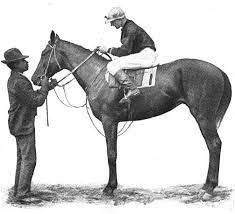
Broomstick Horse
Broomstick was 29 when Stepsister was born in his 24th crop in 1930. He was ten when Crinoline was born in his third crop of 1909. Broomstick was destined to have a 25th crop in 1931, the year Broomstick died. Broomstick was inducted in the Hall of Fame of 1956. Most horses don’t live to be 30 years of age—Broomstick was having his 25th crop.
As for Valdina Orphan, he did sire a few stakes winners himself. I know he stayed in the breed for a while, there being 69 horses listed at pedigree query dot com, with his blood and Bold Ruler’s blood. 39 have his blood and Northern Dancer. Valdina Orphan’s son SELINSGROVE (USA) b. H, 1952 {13-a} was second in the Ohio Derby, and he became sire of the 2nd dam of MODEST MOE G, 2000 {8-j}. There was a horse that unfortunately brokedown at the Fairgrounds with his blood, WHODATRUNNER (USA) ch. M, 2010 {2}. So Valdina Orphan may still be in a few pedigrees.


